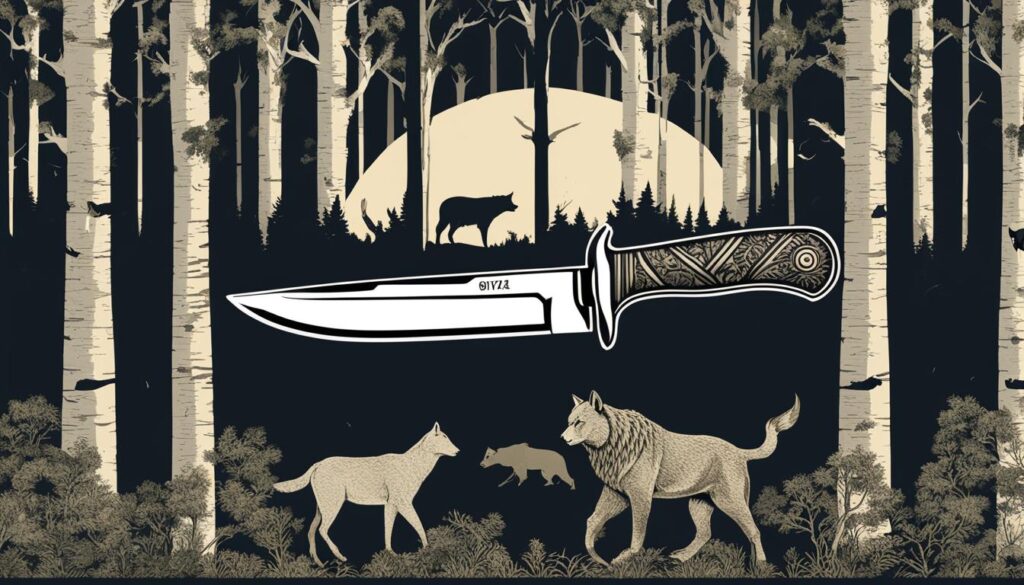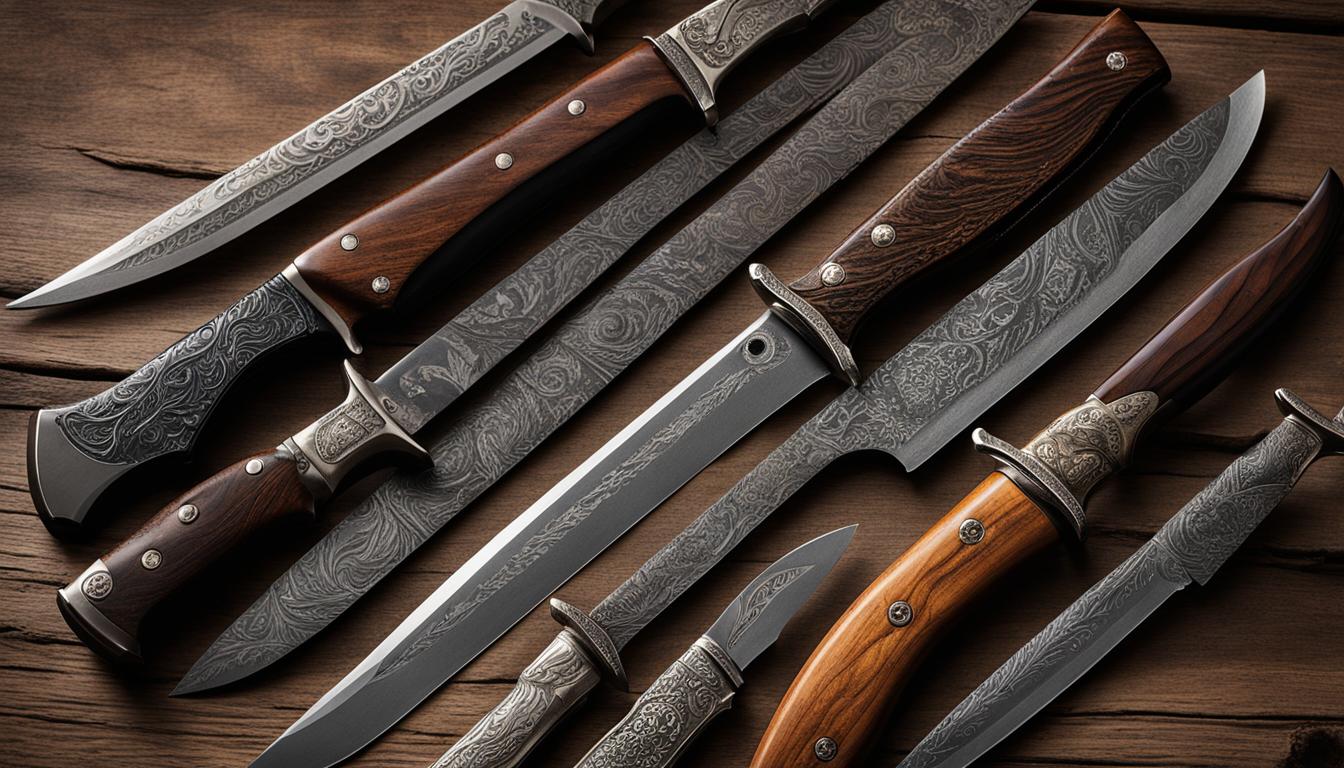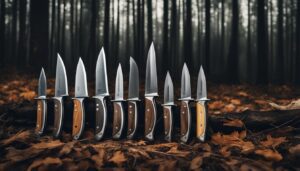Welcome to my ultimate guide on choosing the perfect blade size for your hunting knives. Whether you’re an experienced hunter or just starting out, selecting the right blade size is crucial for optimal performance and functionality. In this guide, I will provide expert recommendations based on factual data and insights from Texan Knives, Timothy Martinez Jr., and other reliable sources.
Key Takeaways:
- Blade size is an important factor in determining a hunting knife’s performance for various tasks.
- Texan Knives offers a wide range of hunting knives with different blade sizes to meet different needs.
- Fixed blade knives, hunting knives, survival knives, folding knives, EDC knives, multi-tool knives, fishing knives, and fillet knives are the main types of outdoor knives with varying blade sizes.
- Factors like purpose, size and weight, blade material, handle material, and budget should be considered when choosing blade size.
- Proper maintenance, including cleaning, sharpening, lubrication, storage, and routine inspection, is essential for hunting knife longevity and performance.
Types of Outdoor Knives and Their Blade Sizes
When it comes to outdoor knives, there are various types designed for specific purposes and tasks. Each type has its own unique features and blade sizes, making it important to understand their differences and choose the one that best suits your needs.
Fixed Blade Knives
Fixed blade knives have a solid, unmovable blade that offers exceptional strength and stability. These knives are an excellent choice for hunters and individuals who require a reliable tool for demanding outdoor tasks. The blade sizes vary depending on the specific purpose, with larger blades offering more strength and versatility.
Hunting Knives
Hunting knives are specifically designed for hunters and feature a strong, sharp blade with a curved edge for skinning and field dressing games. These knives come in various blade sizes, allowing hunters to choose the one that suits their preferred hunting style and game size.
Survival Knives
Survival knives are built for versatility and durability. They are designed to handle a variety of tasks, making them essential tools for outdoor enthusiasts and adventurers. These knives often have medium-sized blades that strike a balance between utility and portability.
Folding Knives
Folding knives, also known as pocket knives, are ideal for everyday use or light outdoor tasks. They offer the advantage of portability and easy storage due to their folding mechanism. Blade sizes of folding knives can vary, but they are typically smaller than fixed blade knives.
EDC Knives
EDC (Everyday Carry) knives are lightweight and versatile tools designed for everyday use. These knives come in various blade sizes, allowing users to choose the one that fits their specific needs. EDC knives are popular among individuals who require a reliable and convenient tool for everyday tasks.
Multi-Tool Knives
Multi-tool knives combine a knife with other essential tools, making them perfect for campers, hikers, and outdoor enthusiasts. These knives often have smaller blades to accommodate the additional tools. The blade sizes may vary depending on the specific multi-tool knife model.
Fishing Knives
Fishing knives, such as fillet knives, are specialized tools for cleaning and preparing fish. These knives have thin, flexible blades that make it easier to remove skin and bones. Blade sizes for fishing knives can vary depending on the size of the fish and the specific cleaning technique.
Understanding the different types of outdoor knives and their blade sizes is crucial for choosing the right tool for your specific needs. Whether you’re a hunter, outdoor enthusiast, or someone who needs a reliable everyday carry knife, selecting the appropriate blade size ensures optimal performance and functionality.
Factors to Consider When Choosing Blade Size
When selecting a hunting knife, it’s essential to consider various factors to ensure the blade size matches your specific needs and tasks. One important factor to consider is the purpose of the knife and the specific tasks you’ll be using it for. Different tasks require different blade sizes for optimal performance and efficiency.
Consideration 1: Purpose
The purpose of the knife will determine the ideal blade size. For example, if you’ll be primarily using the knife for small game hunting or everyday tasks such as cutting ropes or opening packages, a smaller blade size may be more practical. On the other hand, if you’ll be engaging in larger game hunting or more heavy-duty outdoor activities, a larger blade size would be more appropriate.
Consideration 2: Size and Weight
Size and weight are important factors to consider for personal comfort and ease of use. If you prefer a lightweight and compact knife for easy handling and portability, a smaller blade size would be preferable. However, if you prioritize strength and stability for tasks that require more force, a larger blade size may be necessary.
Consideration 3: Blade Material
The material of the blade will impact its performance and durability. Different blade materials have varying strengths, sharpness retention, and corrosion resistance. Consider the type of tasks you’ll be performing and choose a blade material that aligns with your needs and preferences.
Consideration 4: Handle Material
The handle material is equally important as it provides grip and comfort during use. The handle should be made of a material that offers a secure hold and is resistant to both moisture and extreme temperatures. It is essential to choose a handle material that complements the blade size and overall functionality of the knife.
Consideration 5: Budget
Your budget will play a role in determining the range of options available to you. Blade size can affect the price of a hunting knife, so it’s important to establish a budget before starting your search. This will help you narrow down your choices and ensure you find a knife that meets your requirements without exceeding your financial limitations.

By considering these factors – purpose, size and weight, blade material, handle material, and budget – you can make an informed decision when choosing the perfect blade size for your hunting knife. Remember to prioritize functionality and comfort to ensure the blade size aligns with your specific needs and preferences.
Maintenance and Care for Your Hunting Knife
Proper maintenance and care are crucial to ensure the longevity and optimal performance of your hunting knife. By following these essential steps, you can keep your cherished blade in top shape for years to come.
Cleaning
After each use, it’s vital to clean your hunting knife thoroughly. Gently wipe the blade to remove any dirt, debris, or moisture. Use mild soap and water for stubborn stains, and make sure to dry the knife completely before storing it.
Sharpening
A sharp hunting knife is a reliable tool. Regular sharpening helps maintain the blade’s edge and cutting performance. Use a sharpening stone or a honing rod to restore the sharpness, taking care to follow the manufacturer’s instructions and maintaining the proper angle.
Lubrication
For folding knives, proper lubrication of the pivot area and locking mechanism is essential for smooth operation. Apply a small amount of lubricant, such as oil or silicone-based lubricant, to ensure that the knife opens and closes smoothly without any resistance.
Storage and Routine Inspection
When your hunting knife is not in use, store it in a dry, cool environment. Avoid exposing it to moisture or extreme temperatures, as this can lead to rust and corrosion. Regularly inspect the knife for signs of wear, damage, or rust, ensuring that the handle is secure and there are no loose components.
By following these maintenance practices, you can keep your hunting knife in excellent condition, ensuring it remains a reliable and valuable tool for all your outdoor adventures.
FAQ
What factors should I consider when choosing the blade size for a hunting knife?
When selecting a hunting knife, it’s important to consider the purpose of the knife and the specific tasks you’ll be using it for. The size and weight of the knife are also crucial factors to consider. Additionally, blade material and handle material should be taken into account. Lastly, determining your budget before shopping for a hunting knife is essential.
What types of outdoor knives are available with different blade sizes?
There are various types of outdoor knives with different blade sizes. Fixed blade knives, hunting knives, survival knives, folding knives, EDC knives, multi-tool knives, and fishing knives, such as fillet knives, are all available in different blade sizes.
How should I maintain and care for my hunting knife?
Proper maintenance and care are essential for the longevity and optimal performance of your hunting knife. After each use, it’s important to clean the knife thoroughly to remove dirt, debris, and moisture. Regular sharpening is necessary to maintain the knife’s edge. Lubricating the pivot area and locking mechanism for folding knives ensures smooth operation. Storing the knife in a dry, cool environment when not in use helps prevent rust and corrosion. Regularly inspecting the knife for signs of wear, damage, or rust allows you to address any issues promptly and maintain its condition.





